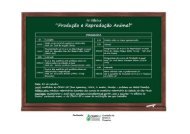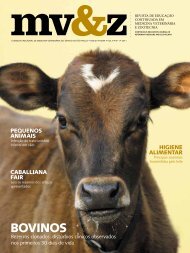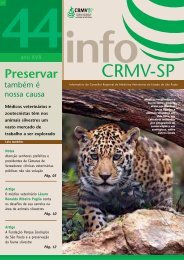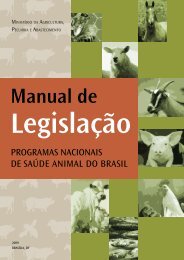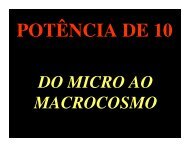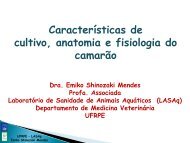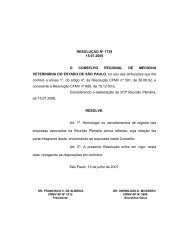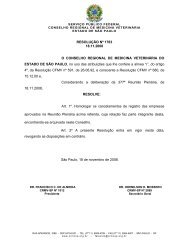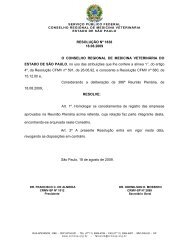mv&z
Vol. 11 - nº 1 - 2013 - CRMV-SP
Vol. 11 - nº 1 - 2013 - CRMV-SP
- No tags were found...
You also want an ePaper? Increase the reach of your titles
YUMPU automatically turns print PDFs into web optimized ePapers that Google loves.
X X I I I R I T A B r a z i lXXIII RITA Brazil – Rabies in the AmericasXXIII Reunião Internacional da Raiva nas Américas14 a 18 de outubro de 2012Hotel Maksoud PlazaSão Paulo – BrasilContinuação dos resumos apresentados na Revista MV&Zvol. 10 – nº 2 e 3 – 2012PT.091ANTIGENIC CHARACTERIZATION OF RABID ANIMALISOLATES, NORTHERN BRAZIL, 2008/2012.Casseb LMN 1 , Coelho TFSB 1 , Pereira AS 1 , Ferro MNP 1 , Lopes NRS 2 , BegotAL 3 , Lima RJS 4 , Vasconcelos PFC 1 , Travassos da Rosa ES 1 – 1 InstitutoEvandro Chagas – Seção de Arbovirologia e Febres Hemorrágicas,2Universidade Federal Rural da Amazônia, 3 Secretaria de Estado de SaúdePública – Núcleo de Doenças Endêmicas de Estado do Pará, 4 Núcleo deDoenças Endêmicas de Estado do ParáIntroduction: The identification of the antigenic variants of rabies virusfurnish important information on the origin of the circulating rabies virus ina determined region and, in consequence, the existing cycles and the involvedspecies on them.Aiming to extend the knowledge of the epidemiology of the rabies innorthern Brazil, we incorporated the technique of antigenic characterizationfor the laboratorial diagnosis of the rabies. Objective: To determine theepidemiologic profile of the animal rabies in northern Brazil, during theperiod of January 2008 through July 2012.Method: A total of 32 rabies virus isolates from wild and domesticanimals were used for antigenic characterization as follows: 21 dogs, a cat, fivebovine, three equine and two bats all of them from Pará State. The IndirectImunofluorescence Assay (IIFA) was performed using a panel of monoclonalantibodies against the rabies virus nucleoprotein (produced by CDC/Atlanta,USA), One dog rabid sample was genetic characterizated performed using theassay of RT-PCR in two steps seconds Barbosa et al (2007).Results: The 20 dog isolates and one cat sample were identified as Variant2, strain commonly found among dogs; all bovine, equine and bat rabid samples(nonhematophagous) were identified as Variant 3, whose reservoir is thehematophagous bat Desmodus rotundus, a sample of dog, not compatible withthe panel, was characterized genetically as VAg3. Conclusions: These resultssuggest that in the northern region of Brazil the antigenic variant 2 continuesto be the prevalent in dogs; the other strains were antigenically characterized asbelong to the variant 3 (from vampire bats). The genetic characterizations of allstudied strains are on going and should complement this study.Financial support: CNPq/MCT and IEC/SVS/MSPT.092ANTIGENIC AND GENOTYPIC CHARACTERIZATION OFRABIES VIRUS ISOLATES FROM BATS FROM BOTUCATUCITY AND REGIONMenozzi BD 1 , Carrieri ML, Oliveira RN, Pereira VBR, Langoni H – 1 Unesp– DHVSPFor some time ago, bats are receiving an increased importance in PublicHealth because they are considered the main reservoirs of rabies virus aroundthe world, including Brazil. Although bats remain the rabies epidemiologicalcycles for centuries, only in the last decades the rabies in bats had itsrecognition, throughout researches focused on the role of these animals inthe epidemiological cycle of the disease and also on their variants and theirimplications in the development of new reservoirs for rabies virus, mainlyin regions where the disease in dogs was controlled. The state of São Paulo,coordinated by the Institute Pasteur, performs epidemiological surveillance forrabies through registered laboratories for its diagnosis. The labs of ZoonosisDiagnostic Service, School of Veterinary Medicine and Animal Science –UNESP – Botucatu – SP is registered for receiving material for diagnosis ofsome municipalities of the region.Between 2003 and 2010, 19 samples of non-hematophagous bats werediagnosed as positive by IFD and Biological Evidence. These isolates wereantigenically characterized by the panel of monoclonal antibodies donated byPAHO-CDC (Centers for Disease Control and Prevention, Atlanta, GA, USAPan-American Health), revealing seven of these isolates belonged to variant3, which has the vampire bat Desmodus rotundus as reservoir, as well as aninsectivorous bat of the genus Myotis presenting variant 4, characterisitc of theother insectivorous bat Tadarida brasiliensis, and other three profiles are notcompatible, NC-1, NC-2 and NC-3. All isolates were assayed by RT-PCR and theirproducts had the nucleoprotein gene (N) viral partially sequenced, generating aphylogenetic tree that grouped these isolates into four clusters, designated aslineages Nyctinomops, Myotis, Desmodus rotundus, and a new lineage of rabiesvirus not previously characterized, which apparently has the bats of the genusMyotis as reservoir. This lineage showed an average intraspecific identity of99.8%, ranging from 99.6 to 100% for nucleotides and 100% amino acids.c r m v s p . g o v . b rmv&z45




